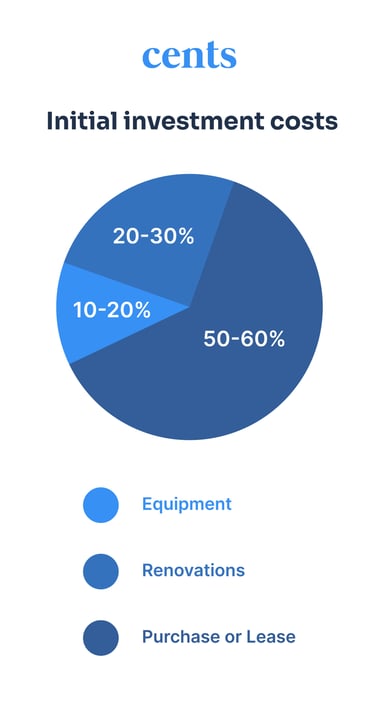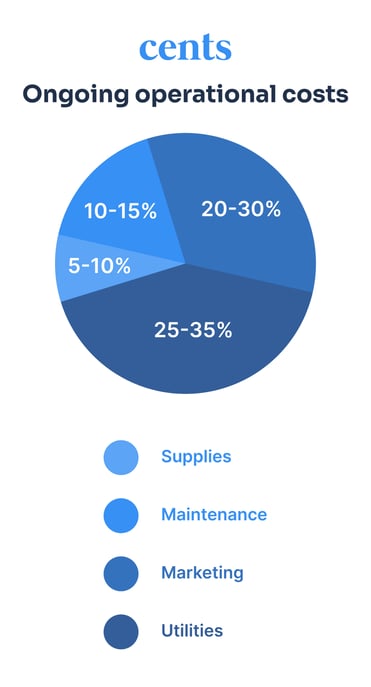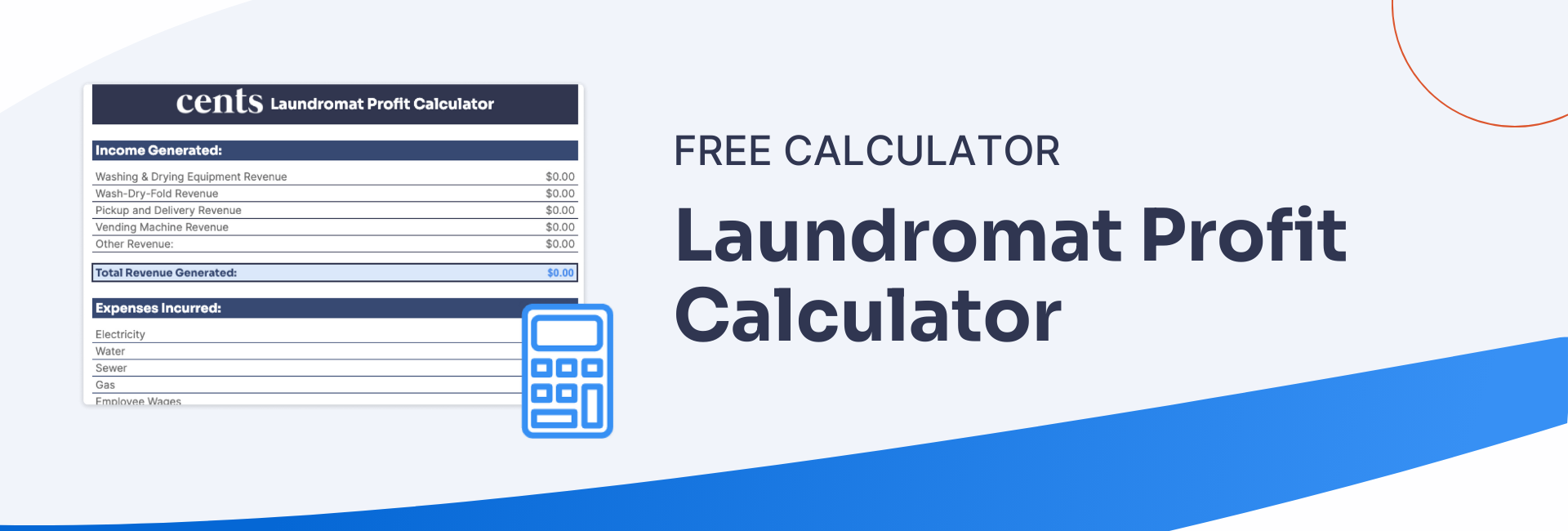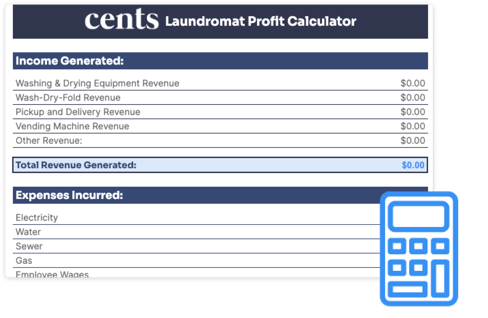As attractive as laundromat profit margins are, it’s important to consider the start-up and average laundromat costs that go into opening and running a laundry business. Like many new businesses, the investment can be considerable, but worth its salt for driven laundromat investors. Here’s a comprehensive cost analysis so you can truly understand your laundromat purchase.
Download our laundromat profit calculator to find out how much profit your laundromat is making each month, quarter, and year.
How Much is a Laundromat Worth? Understanding Laundromat Valuation
U.S. Laundromats post impressive numbers with a 95% average success rate and 20 - 35% profit margins. But whether or not your laundromat can meet (or exceed) these industry standards depends on some important factors.
Important factors that contribute to laundromat value:
-
Location: As mentioned, a prime location is crucial. Situating your business in high-traffic areas, near apartment complexes, or in neighborhoods with a high percentage of renters can boost visibility and customer access.
-
Equipment quality and technology: Advanced machines with features like card payments, energy efficiency, and faster cycles can attract more customers. The integration of technology for remote monitoring and management also adds value.
-
Customer base: Building a reliable customer base through excellent service, loyalty programs, and community engagement will help bolster your success. A strong reputation in the community can be a major asset.
-
Market demand: Understanding the local market demand and the level of competition is key. Areas with a higher demand for laundry services and less saturation can be more lucrative.
-
Service diversification: Offering a range of services, such as wash-and-fold, dry cleaning, or pickup and delivery, can differentiate you from local competition and broaden the customer base.
-
Store amenities: The physical appearance and comfort of the laundromat, including cleanliness, lighting, seating, and additional amenities like Wi-Fi, snack machines, an in-store café, or arcade machines can improve customer experience and retention.
-
Expansion potential: The ability to scale up operations or expand services over time without significant additional investment adds long-term value to the laundromat and gives you the opportunity to fatten your margins.
Average Laundromat Cost: Initial Investment Breakdown

One of the looming questions you may be asking yourself as a new laundromat investor is, how much does a laundromat cost? Getting into this business, while financially rewarding, can require a significant initial investment based on several factors:
Purchase or lease
The decision to buy or lease the premises forms a significant part of your costs to opening a laundromat.
-
Purchase price: Buying a property outright can range from $200,000 to $1,000,000, depending on location and size. Owning the property can provide long-term stability but requires a substantial upfront investment.
-
Leasing costs: Leasing is less capital-intensive upfront and can cost between $1,500 to $5,000 per month. However, this could be more expensive over time and offers less control over the property.
Renovations
Renovation costs can be pretty variable. For an existing laundromat, upgrades might be necessary to meet current standards and enhance customer experience. This could include new flooring, painting, lighting, or restroom facilities. Renovation costs typically range from $50,000 to $200,000. Upgrading utility systems like plumbing and electrical to support high-capacity machines is often necessary and can be a substantial part of your renovation budget.
Initial equipment setup
The heart of your laundromat is its equipment. A set of new, commercial-grade washers and dryers can cost between $100,000 to $300,000. The price varies based on the machine's capacity, efficiency, and technology features. Additional equipment like change machines, laundry carts, and seating areas also add to the cost.
Old laundromat conditions
Purchasing an existing laundromat can be a double-edged sword. While it may come with an established customer base and operational setup, older laundromats often require significant upgrades to equipment and facilities. This is essential to stay competitive and meet customer expectations.
Buying a laundromat is a complicated and meticulous process. Read the complete guide How to Buy a Laundromat for exclusive pro tips.
Laundromat Revenue vs Operation Costs: What to Expect

The choice between running a self-service or full-service laundromat significantly impacts both the business model and the associated expenses. Running a careful audit of these differences will set you up for effective financial planning and pricing strategies.
Self-Service Laundromats
Self-service laundromats primarily provide the equipment and space for customers to do their laundry. The cost structure for a self-service model generally includes:
-
Utilities: The largest ongoing cost, including water, electricity, and gas. Although these costs can be substantial, they are often lower per machine compared to a full-service model due to less frequent use.
-
Supplies: This includes maintenance supplies for machines and general cleaning supplies for the facility.
-
Maintenance: Regular servicing of machines to prevent breakdowns is a key expense.
-
Insurance and rent: Although not the primary focus here, these costs still form a significant part of the budget.
Full-service laundromats
Full-service models offer additional services like wash-and-fold, dry cleaning, and sometimes even ironing. This model entails higher operational costs due to the added services:
-
Staffing: Labor costs are the most significant difference. Staffing for receiving, washing, folding, and customer service increases the operational budget.
-
Supplies: Additional supplies such as detergents, fabric softeners, and packaging for finished laundry are necessary.
-
Utility usage: Higher frequency of machine use results in increased utility costs compared to self-service models. Luckily there are ways you can save on utility costs.
-
Maintenance: More frequent use of machines necessitates more regular maintenance.
Pickup and delivery services
Offering pickup and delivery adds another layer of complexity and cost:
-
Vehicle expenses: Costs include purchasing or leasing vehicles, fuel, maintenance, and insurance.
-
Staffing for delivery: Drivers and staff managing logistics increase labor costs.
-
Operational management: Coordinating pickup and delivery schedules requires efficient management, often facilitated by specialized software.
-
Equipment upgrades: Staying up-to-date with technology and replacing aging machines is more critical in full-service models.
-
Building maintenance: More frequent customer turnover in self-service laundromats might increase wear and tear on the facility.
Laundromat Revenue: How Much Can You Make?
While earnings vary based on location, services, and operational efficiency, laundromats remain one of the most stable and profitable small businesses.
Average Laundromat Revenue
According to industry data, the average laundromat generates between $200,000 and $500,000 in annual revenue, depending on factors such as size, service offerings, and market demand. Self-service laundromats typically bring in $15,000 to $30,000 per month, while full-service laundromats with wash-and-fold, pickup, and delivery options can earn even more.
Revenue Breakdown by Service Type
Different laundromat models generate revenue in unique ways:
-
Self-Service Only: Customers pay per wash and dry cycle, with an average revenue of $4 to $6 per load.
-
Wash-and-Fold Services: Priced at $1.25 to $2 per pound, with the potential to generate $5,000 to $15,000 per month.
-
Pickup & Delivery: Premium service that can increase revenue by 20-40%, depending on demand.
-
Ancillary Services: Vending machines, detergent sales, and arcade machines can add an extra $500 to $2,000 per month.
Effect of cost changes
Any significant change in costs, particularly utilities and labor, can impact profitability. For instance, a rise in utility rates will affect both self-service and full-service models but might be more pronounced in the latter due to higher usage rates.
Maximizing Laundromat Revenue
To increase your laundromat’s revenue potential:
-
Invest in energy-efficient machines to reduce costs and maximize profit.
-
Implement digital payment options to attract cashless customers.
-
Offer membership plans or discounts to encourage repeat visits.
-
Expand into commercial laundry contracts with hotels, gyms, and restaurants.
By strategically managing costs and optimizing services, a laundromat can generate substantial and stable revenue, making it a lucrative investment opportunity.
Pricing strategies for profit
Pricing should reflect the cost structure of your business model. Full-service laundromats typically charge a premium for the added convenience and labor-intensive services they offer. Understanding your operational costs is crucial for setting prices that cover expenses while remaining competitive and profitable.
How Profitable Are Laundromats? Profitability and ROI Breakdown
In addition to laundromat setup costs, you need to think about how they translate into profitability. This assessment involves examining the return on investment (ROI) and determining the break-even points, which are critical for sustaining and growing the business.
Analyzing profitability
Profitability in the laundromat business is influenced by a balance between operational costs and revenue generated. Key factors include:
-
Revenue streams: This encompasses income from self-service laundry, full-service offerings (like wash-and-fold), and any ancillary services like vending machines or pickup and delivery services.
-
Operational efficiency: Keeping operational costs, such as utilities, supplies, and staffing, in check is crucial. Efficient operations can significantly boost profitability.
-
Pricing strategy: Setting the right prices for various services determines revenue potential. Pricing needs to cover costs while remaining attractive to customers. [Link to laundromat pricing strategies].
ROI and break-even analysis
The ROI for a laundromat involves calculating the return relative to the initial and ongoing investments. Key considerations include:
-
Initial investment: The total cost for starting the laundromat, including purchase/lease, equipment, renovations, and setup.
-
Ongoing costs: Regular expenses like utilities, supplies, staffing, and maintenance.
-
Revenue generation: The total income from all services offered by the laundromat.
The break-even point is reached when total revenues equal total costs, signifying that the business is no longer operating at a loss but has not yet started making a profit. This point is crucial as it provides a timeline for when the investment starts paying off.
Using the Cents ROI Calculator
Tools like the Cents ROI Calculator can be instrumental in providing laundromat owners with a clear picture of their financial standing. By inputting specific data about costs and revenues, owners can get an accurate estimate of their ROI and break-even point. This tool aids in making informed decisions about pricing, cost management, and potential investments.
Pricing services for profit
Effective pricing strategies are vital for ensuring profitability. This involves:
-
Competitive analysis: Understanding local market rates for laundry services.
-
Cost-based pricing: Ensuring that all prices cover costs and contribute to profit margins.
-
Value-based pricing: Setting prices based on the perceived value of the services to the customers, especially for full-service offerings.
Emergency fees + hidden costs
Every business has its share of unanticipated expenses, including laundromats! Putting money aside for a rainy day is crucial for maintaining financial stability and ensuring long-term success. Keep reading for some instances of “hidden” costs you should be prepared for as a laundromat owner.
Contingency funds
Setting aside a contingency fund is a wise financial strategy for any laundromat owner. This fund acts as a safety net for unexpected expenses. It's recommended to reserve about 5-10% of annual revenue for such emergencies. This allocation can help cover sudden costs without disrupting the regular cash flow or dipping into profits.
Insurance premiums
Insurance is an essential aspect of protecting your business. Premiums typically range from 2-5% of your annual expenses but provide crucial coverage against a variety of risks, including property damage, liability issues, and business interruption. This expense, while seemingly an added cost, can save substantial amounts in the event of an unforeseen circumstance.
Machine breakdowns
One of the most common unexpected expenses in a laundromat is machine breakdowns. The cost of repairs or replacements can be significant, especially if multiple machines fail simultaneously. Regular maintenance can mitigate this risk, but it's vital to have funds allocated for such occurrences.
Damage to storefront and theft
Physical damage to your laundromat, whether from natural events, accidents, or vandalism, can lead to unexpected repair costs. Similarly, theft can result in losses, not just in terms of stolen cash or damaged property but also in business interruption. Investing in security measures and having a contingency fund for such instances is important.
Staffing fluctuations
Unexpected changes in staffing, such as the sudden departure of a key employee, can incur costs related to hiring and training new staff. While not a frequent expense, it's one that requires foresight and planning.
Cost increases
Utility costs, supplies, machine upgrades, and taxes are subject to fluctuations and can increase over time. These cost increases, while not sudden, are often overlooked and can creep up, impacting your bottom line. Regularly reviewing and adjusting your budget and prices can help manage these gradual increases and even save you money on utility costs.
Cost-saving strategies
-1.png?width=397&height=441&name=Blog%20Frame%20Templates%20(5)-1.png)
It's crucial to consider both initial investments and ongoing operational costs. Employing a mix of due diligence, negotiation strategies, modern technology integrations, and energy-efficient appliances can lead to significant savings.
Operational costs
-
Energy-efficient appliances: Upgrading to energy-efficient washers and dryers can drastically reduce electricity and water consumption. Though the initial cost might be higher, the long-term savings in utility bills are substantial. Additionally, customers are increasingly eco-conscious, so this can also be a unique selling proposition.
-
Smart technology integration: Utilize software solutions for equipment monitoring and maintenance. This not only prevents downtime but also optimizes the usage of resources. Automated systems can adjust resource usage based on load, leading to more efficient operations.
-
Preventative maintenance: Regular maintenance of equipment can avoid costly repairs and extend the life of the machines. Software can be used to track maintenance schedules and alert managers when service is due.
-
Volume discounts: Purchasing supplies in bulk can lead to significant cost savings. Explore opportunities for partnerships or collective buying with other local businesses to negotiate better deals.
Read more: How to Save on Laundromat Operating Costs
Initial investment and due diligence
-
Market research and location Analysis: Before investing, thorough market research is essential. Analyzing the local demand, competition, and customer demographics can inform better decisions and potentially save significant investment costs.
-
Negotiation skills: When acquiring a laundromat, negotiation plays a key role. Understanding the true value of the business and effectively negotiating the purchase price can lead to initial cost savings.
-
Seeking expert advice: Consulting with industry experts or using due diligence services can uncover hidden costs or issues with a potential investment, thereby avoiding expensive mistakes.
-
Financing options: Explore various financing options to find the most cost-effective choice. Sometimes, a slightly higher interest rate with better terms can be more beneficial in the long run.
Reference: Guide on Laundromat Due Diligence
Starting your investment process
Embarking on a laundromat venture demands strategic planning and informed decision-making, from selecting the ideal location to choosing the appropriate business model. Initial investments, including property acquisition or leasing, renovations, and equipment setup, lay the groundwork for your business's future success. Success in the laundromat industry hinges not only on understanding the average costs of owning a laundromat but also on your ability to adapt to market trends, leverage modern software solutions for operational management, and consistently meet customer needs. By combining careful planning with efficient operation and a proactive approach, your laundromat can achieve financial prosperity and become a valued asset in your community.
FAQ about laundromat costs
What factors most significantly impact the value of a laundromat?
Location, equipment quality, customer base, and operational efficiency are key factors. A prime location, modern equipment, and a loyal customer base significantly enhance a laundromat's value.
How much does it cost to start a laundromat?
Initial costs range from $200,000 to $500,000, encompassing purchase or leasing, renovations, equipment, and legal expenses. The exact figure varies based on location, size, and equipment quality.
What are the costs and risks of owning a laundromat?
Key costs include utilities, supplies, maintenance, and staffing. Risks involve fluctuating market conditions, increasing utility prices, and potential competition.
Is a laundromat worth owning?
With proper management, a laundromat can be a highly profitable investment. The key is to balance initial costs with operational efficiency to maximize return on investment.
Download our laundromat profit calculator to find out how much profit your laundromat is making each month, quarter, and year.
.png?width=2196&height=2196&name=OS%20(1).png)

-3.png?width=224&height=213&name=Accelerate%20(2)-3.png)









.png?width=400&height=200&name=Thumbnail%20(3).png)
![A Buyer's Guide to Laundromat Due Diligence [Checklist]](https://www.trycents.com/hs-fs/hubfs/The%20Cents%20Guide%20to%20Laundromat%20Due%20Diligence%202.jpg?width=400&height=200&name=The%20Cents%20Guide%20to%20Laundromat%20Due%20Diligence%202.jpg)